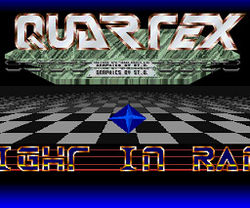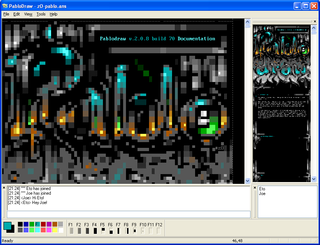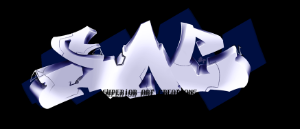
ASCII art is a graphic design technique that uses computers for presentation and consists of pictures pieced together from the 95 printable characters defined by the ASCII Standard from 1963 and ASCII compliant character sets with proprietary extended characters. The term is also loosely used to refer to text-based visual art in general. ASCII art can be created with any text editor, and is often used with free-form languages. Most examples of ASCII art require a fixed-width font such as Courier for presentation.
Software cracking is the modification of software to remove or disable features which are considered undesirable by the person cracking the software, especially copy protection features or software annoyances like nag screens and adware.

Warez is a common computing and broader cultural term referring to pirated software that is distributed via the Internet. Warez is used most commonly as a noun, a plural form of ware, and is intended to be pronounced like the word wares. The circumvention of copy protection (cracking) is an essential step in generating warez, and based on this common mechanism, the software-focused definition has been extended to include other copyright-protected materials, including movies and games. The global array of warez groups has been referred to as "The Scene", deriving from its earlier description as "the warez scene". Distribution and trade of copyrighted works without payment of fees or royalties generally violates national and international copyright laws and agreements. The term warez covers supported as well as unsupported (abandonware) items, and legal prohibitions governing creation and distribution of warez cover both profit-driven and "enthusiast" generators and distributors of such items.

A crack intro, also known as a cracktro, loader, or just intro, is a small introduction sequence added to cracked software. It aims to inform the user which "cracking crew" or individual cracker removed the software's copy protection and distributed the crack.
The computer art scene, or simply artscene, is the community interested and active in the creation of computer-based artwork.
ACiD Productions (ACiD) is a digital art group. Founded in 1990, the group originally specialized in ANSI artwork for BBSes. More recently, they have extended their reach into other graphical media and computer software development. During the BBS-era, their biggest competitor was iCE Advertisements.

PabloDraw is a cross-platform text editor designed for creating ANSI and ASCII art, similar to that of its MS-DOS-based predecessors; ACiDDraw (1994) and TheDraw (1986).
FILE_ID.DIZ is a plain-text file containing a brief description of the content of archive to which it belongs. Such files were originally used in archives distributed through bulletin board systems (BBSes) and is still used in the warez scene. FILE_ID stands for "file identification". DIZ stands for "description in zipfile".
ANSI art is a computer art form that was widely used at one time on bulletin board systems. It is similar to ASCII art, but constructed from a larger set of 256 letters, numbers, and symbols — all codes found in IBM code page 437, often referred to as extended ASCII and used in MS-DOS and Unix environments. ANSI art also contains special ANSI escape sequences that color text with the 16 foreground and 8 background colours offered by ANSI.SYS, an MS-DOS device driver loosely based upon the ANSI X3.64 standard for text terminals. Some ANSI artists take advantage of the cursor control sequences within ANSI X3.64 in order to create animations, commonly referred to as ANSImations. ANSI art and text files which incorporate ANSI codes carry the de facto.ANS file extension.

Superior Art Creations (SAC) is an underground artscene group which caters primarily to and is well known within the warez scene. SAC members have made, besides ANSI and ASCII art, VGA bitmap graphics, tracker music, and a variety of other works. SAC's character graphics have also been used in bottles and FTP servers.
A warez group is a tightly organised group of people involved in creating and/or distributing warez such as movies, music or software ("warez") in The Scene. There are different types of these groups in the Scene: release groups and courier groups. Groups often compete, as being the first to bring out a new quality release can bring status and respect – a type of "vanity contest". The warez groups care about the image others have of them.
International Network of Crackers (INC) was one of the premier cracking/releasing warez groups for the IBM PC during the late 1980s and early 1990s.
The Humble Guys (THG) were a cracking group for the IBM PC during the late 1980s founded by two friends known by the pseudonyms Candyman and Fabulous Furlough. The group was also noticed in the demoscene for some of their cracktros.

The Warez scene, often referred to as The Scene, is a worldwide, underground, organized network of pirate groups specializing in obtaining and illegally releasing digital media for free before their official sale date. The Scene distributes all forms of digital media, including computer games, movies, TV shows, music, and pornography. The Scene is meant to be hidden from the public, only being shared with those within the community. However, as files were commonly leaked outside the community and their popularity grew, some individuals from The Scene began leaking files and uploading them to filehosts, torrents and ed2k.
The United Software Association (USA) was a warez organization which released games and software for the IBM PC platform during the 1990s. USA formed a co-op with the PC warez division of Fairlight which was best known as "USA/FLT". USA was formed as the result of a split of several members from another noteworthy PC group, The Humble Guys (THG). Key members, such as Genesis and The NotSoHumble Babe, left THG, eventually resulting in public displays of animosity.

Creators of Intense Art, or Cia was an underground computer artscene group that primarily released ANSI, ASCII, and high resolution artwork from 1993 to 2001. Along with iCE and ACiD, Cia was one of the most active, and longest lasting groups on the artscene.
Myth was a warez group, focused on cracking and ripping PC games. Besides ripped games, the group also released trainers and cracked updates for games. Myth's slogan, "Myth, always ahead of the Class", was referring to the rival group class that existed from 1997 to 2004.
Aces of ANSI Art was the first group of artists specifically organized for the purposes of creating and distributing ANSI art. The group was founded and operated by two BBS enthusiasts from California, "Zyphril" and "Chips Ahoy", from 1989 through 1991.







